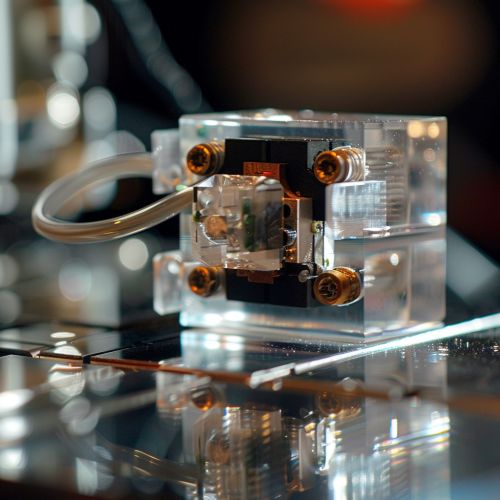Acousto-optic modulator
Acousto-Optic Modulator
An **acousto-optic modulator** (AOM) is a device that uses the interaction between sound waves and light waves to modulate the intensity, frequency, or direction of a laser beam. This interaction is based on the acousto-optic effect, where the refractive index of a material is altered by the presence of an acoustic wave, leading to diffraction of light.


Principles of Operation
The fundamental principle behind an AOM is the acousto-optic effect, also known as the photoelastic effect. When an acoustic wave propagates through a medium, it creates periodic variations in the refractive index due to the strain induced by the sound wave. These variations act as a diffraction grating for incident light.
Acoustic Wave Generation
An acoustic wave is typically generated using a piezoelectric transducer, which converts an electrical signal into a mechanical vibration. This transducer is bonded to a crystal, such as quartz or tellurium dioxide, which supports the propagation of the acoustic wave. The frequency of the acoustic wave is determined by the frequency of the electrical signal applied to the transducer.
Light Diffraction
When a laser beam enters the modulator, it interacts with the periodic refractive index variations created by the acoustic wave. This interaction causes the light to be diffracted into several orders. The intensity and angle of the diffracted beams depend on the acoustic wave's frequency and amplitude.
Types of Acousto-Optic Modulators
There are several types of AOMs, categorized based on their configuration and the nature of the interaction between the acoustic and optical waves.
Bragg Cell Modulators
In Bragg cell modulators, the interaction length between the light and the acoustic wave is long, leading to a strong diffraction effect. These modulators operate in the Bragg regime, where the light is predominantly diffracted into a single order. They are commonly used for frequency shifting and beam deflection applications.
Raman-Nath Modulators
Raman-Nath modulators have a shorter interaction length, resulting in multiple diffraction orders. These modulators operate in the Raman-Nath regime and are typically used for applications requiring multiple beam generation or complex beam shaping.
Applications
AOMs are used in a variety of applications across different fields, including:
Laser Frequency Control
AOMs can be used to shift the frequency of a laser beam by an amount equal to the frequency of the acoustic wave. This capability is essential in laser spectroscopy and laser cooling experiments, where precise control over the laser frequency is required.
Intensity Modulation
By varying the amplitude of the acoustic wave, the intensity of the diffracted light can be modulated. This feature is useful in optical communication systems and laser scanning applications, where controlled light intensity is necessary.
Beam Deflection
AOMs can deflect a laser beam by changing the frequency of the acoustic wave. This property is utilized in laser printers, optical tweezers, and confocal microscopy to steer the laser beam with high precision.
Design Considerations
The performance of an AOM depends on several design parameters, including the choice of material, the frequency of the acoustic wave, and the configuration of the modulator.
Material Selection
The material used in an AOM must have good acousto-optic properties, such as a high acousto-optic figure of merit and low acoustic attenuation. Common materials include quartz, tellurium dioxide, and lithium niobate.
Frequency and Bandwidth
The frequency of the acoustic wave determines the diffraction efficiency and the deflection angle of the modulated light. Higher frequencies generally result in higher diffraction efficiencies. The bandwidth of the AOM is also a critical parameter, as it defines the range of frequencies over which the modulator can operate effectively.
Configuration
The configuration of the AOM, including the orientation of the crystal and the placement of the transducer, affects the interaction length and the efficiency of the modulation. Optimizing these parameters is essential for achieving high-performance modulation.
Advanced Topics
Nonlinear Acousto-Optic Effects
In some cases, the interaction between the acoustic and optical waves can lead to nonlinear effects, such as harmonic generation and parametric amplification. These effects can be exploited for advanced modulation techniques and signal processing applications.
Integrated Acousto-Optic Devices
Recent advancements in integrated optics have led to the development of on-chip AOMs, which integrate the acousto-optic interaction within a photonic circuit. These devices offer compact and efficient solutions for optical modulation in integrated photonic systems.
